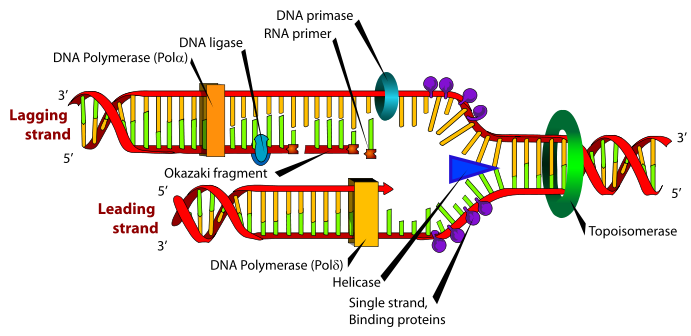DNA replication
DNA replication is a biological procedure which occurs in all living copies and organisms their DNA it is the basis for biological inheritance. The procedure begins when one double-stranded DNA molecule produces two identical copies of the molecule. DNA cell cycle also pertains to the DNA replication or reproduction procedure. The cell cycle includes anaphase, prophase, interphase, telophase and metaphase. Every strand of the original double-stranded DNA molecule serves as sample for the production of the complementary strand a process referred to as semiconservative replication. The Cellular proofreading and error toe-checking mechanisms ensure near perfect fidelity for DNA replication.
DNA replication can also be performed in vitro. The DNA polymerases isolated from cells and artificial DNA primers are used to initiate DNA synthesis at known sequences in a template molecule. The polymerase chain reaction, a general laboratory technique employs like artificial synthesis in a cyclic manner to amplify a specific goal DNA fragment from a pool of DNA.

DNA replication in all organisms takes place through same mechanisms but much of the detail has been gained from our understanding of the molecular biology of the bacterium Escherichia coli. In all bacteria DNA replication is triggered through cell mass but the speed of genomic duplication varies from species to species. In E. coli new bases are added at approximately 1000 nucleotides per second nt s-1 but in Mycoplasma capricolum this rate falls to only 100 nt s-1. This means that although the mycoplasma has a considerably smaller genome both bacteria can completely replicate their genomes in around 45 minutes.
There are two rules which govern how DNA replication can occur. The first is that replication is semi-conservative in that double-stranded DNA is separated and each strand acts as a template for synthesis of a new strand composed of bases exactly complementary to the template. The second is that all nucleic acid polymerases synthesize DNA in a 5? to 3? direction using a primer to initiate synthesis. This primer is RNA whether or not DNA or RNA is to be synthesized. Nucleotides are added to the exposed 3?-hydroxyl group of the primer so in which they are exactly complementary to the template strand A matched with T or U; C matched with G.